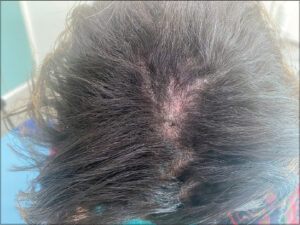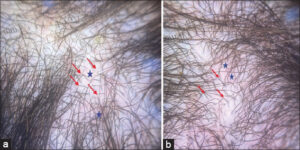Hair breakage caused by straightening products in a young female
Jihad Kassel , Hanane Baybay, Chaymae Jroundi, Sara Elloudi, Zakia Douhi, Fatima-Zahra Mernissi
, Hanane Baybay, Chaymae Jroundi, Sara Elloudi, Zakia Douhi, Fatima-Zahra Mernissi
Department of Dermatology, University Hospital Hassan II, Fes, Morocco
Citation tools:
Copyright information
© Our Dermatology Online 2023. No commercial re-use. See rights and permissions. Published by Our Dermatology Online.
In almost all civilizations, the hair bears special importance: it is a synonym of beauty and strength. Having smooth and easy-to-style hair is a constant demand of women and also men. Hair straighteners are highly popular around the world, although they may cause great damage to the hair [1], such as breakage, falling, burns, and eczema [2]. The manifestations of hair breakage caused by straightening may be heterogeneous, ranging from poor hair growth to patchy alopecia. A dermoscopic examination of hairs obtained by a pull test allowed us to diagnose hair breakage in all cases. The hair fragments had no roots, yet rather brush-like tips and swelling along the shaft caused by trichorrhexis nodosa. Central trichoptilosis (longitudinal split in the central part of the shaft) was another common finding [3].
Herein, we report the case of a 34-year-old female patient with no notable pathological history who consulted us for hair loss and pruritus on the scalp three days after the application of a straightening product. On examination, the traction sign was positive in some places, and we also noted erythema on the scalp (Fig. 1) with small vehicles on the frontal edge. A dermoscopic examination revealed an erythematous background with broken, bent hairs on the entirety of the hair (Figs. 2a and 2b). Our patient was administered a shampoo based on corticoids.
Consent
The examination of the patient was conducted according to the principles of the Declaration of Helsinki.
The authors certify that they have obtained all appropriate patient consent forms, in which the patients gave their consent for images and other clinical information to be included in the journal. The patients understand that their names and initials will not be published and due effort will be made to conceal their identity, but that anonymity cannot be guaranteed.
REFERENCES
1. Barreto T, Weffort F, Frattini S, Pinto G, Damasco P, Melo D. Straight to the point:What do we know so far on hair straightening?Skin Appendage Disord. 2021;7:265-71.
2. Tennstedt D, Herman A, Lachapelle JM. Adverse effects of hair care in users. Ann Dermatol Venereol. 2018;145:521-31.
3. Quaresma MV, Martinez Velasco MA, Tosti A. Dermoscopic diagnosis of hair breakage caused by styling procedures in patients of African descent. J Am Acad Dermatol. 2015;72(1 Suppl):S39-S40.
Notes
Request permissions
If you wish to reuse any or all of this article please use the e-mail (brzezoo77@yahoo.com) to contact with publisher.
| Related Articles | Search Authors in |
|
 http://orcid.org/0000-0003-3455-3810 http://orcid.org/0000-0003-3455-3810 http://orcid.org/0000-0002-5942-441X http://orcid.org/0000-0002-5942-441X |






Comments are closed.